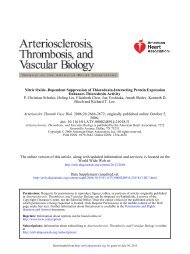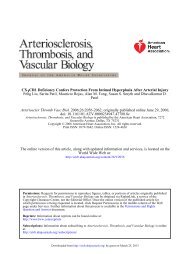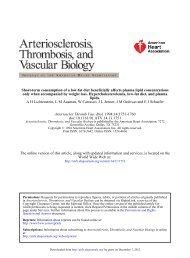Oral Presentations - Arteriosclerosis, Thrombosis, and Vascular ...
Oral Presentations - Arteriosclerosis, Thrombosis, and Vascular ...
Oral Presentations - Arteriosclerosis, Thrombosis, and Vascular ...
Create successful ePaper yourself
Turn your PDF publications into a flip-book with our unique Google optimized e-Paper software.
the increased release of superoxide from the cells. The changes caused by elevated glucose<br />
were associated with loss of zinc content in eNOS <strong>and</strong> were prevented by a NOS inhibitor or<br />
superoxide dismutase, indicating that they were caused by peroxynitrite. Furthermore, eNOS<br />
purified from diabetic low density lipoprotein (LDL) receptor deficient mice, which showed an<br />
increased aortic lesions, had decreased NO synthetic activity, lowered zinc content, <strong>and</strong><br />
decreased enzyme-active eNOS dimers resulting in an increased thiol oxidation <strong>and</strong> increased<br />
generation of oxidants. These observations indicate that in diabetes eNOS is oxidized by<br />
peroxynitrite resulting in an enzymatic uncoupling <strong>and</strong> generation of oxidants contributing<br />
further to the oxidant stresses in these cells. The principal mechanism appears to be oxidation<br />
of the zinc-thiolate complex that maintains the enzyme as active dimers rather than via<br />
oxidation of BH 4. Oxidation of zinc-thiolate cluster of eNOS, therefore, provides a novel<br />
mechanism for modulation of the enzyme function in vivo.<br />
Selectin-Like Bond Kinetics Promote Rapid Platelet Adhesion: The<br />
GPIb-vWF Bond <strong>and</strong> the Impact of Type 2B Mutations<br />
Thomas G Diacovo, Gaurav Girdhar, Avril Lawshe, David W Schmidtke, Ian J Laurenzi, Scott<br />
L Diamond, Teresa A Doggett. Division of Newborn Medicine, Washington University, St.<br />
Louis, MO; Institute for Medicine <strong>and</strong> Engineering, University of Pennsylvania, Philadelphia,<br />
PA<br />
Rapid bond formation <strong>and</strong> dissociation are characteristic of the selectin family of adhesion<br />
receptors that promote the capture <strong>and</strong> translocation of leukocytes on vascular endothelium.<br />
In contrast selectins, the platelet glycoprotein receptor Ib alpha (GP Ib) mediates plateletvessel<br />
wall interactions by binding to the A1 domain of surface-immobilized von Willebr<strong>and</strong><br />
factor (vWF-A1). This receptor-lig<strong>and</strong> pair, however, has been reported to have slow intrinsic<br />
bond kinetics. We now present evidence that the GPIb-vWF-A1 bond has properties previously<br />
identified with selectins: flow dependent adhesion <strong>and</strong> rapid <strong>and</strong> force-dependent bond<br />
kinetics. Characterization of GPIb interactions with plasma vWF or recombinant wt A1 protein<br />
in vitro demonstrates that a critical level of hydrodynamic flow is required to initiate adhesion<br />
between this receptor-lig<strong>and</strong> pair. The dissociation rate constants, koff, for the GPIb vWF-A1<br />
bond, as determined by analysis of pause times, were found to vary exponentially (4.2 0.8<br />
s-1 to 6.9 0.3 s-1) as a function of the force applied to the bond (from 36 to 217pN). The<br />
physiologic significance of bond mechanics in platelet adhesion was exemplified by type 2B von<br />
Willebr<strong>and</strong> disease (vWD), a bleeding disorder resulting from the spontaneous binding of<br />
plasma vWF to circulating platelets. Kinetic analysis of mutations associated with this disorder<br />
revealed a loss of the shear threshold phenomenon, a 6-fold reduction in the intrinsic koff,<br />
<strong>and</strong> a 2-fold increase in the reactive compliance of the bond suggesting a greater propensity<br />
to breakage in response to hydrodynamic force. Thus, the increased bond lifetime observed for<br />
type 2B vWF <strong>and</strong> the concomitant loss of the hydrodynamic threshold requirement for adhesion<br />
demonstrate the deleterious consequences that can result from an alteration in the<br />
biomechanical regulation of a receptor-lig<strong>and</strong> pair. Importantly, our results indicate that<br />
evaluation of receptor-lig<strong>and</strong> interactions under physiological relevant conditions is paramount<br />
to underst<strong>and</strong>ing how biomechanical properties of bonds ultimately control the process of cell<br />
adhesion.<br />
Increased Atherosclerosis in Apo E Deficient Mice Lacking<br />
Macrophage-Derived ACAT1<br />
Yan Ru Su, Dwayne Dove, Amy Major, Alyssa Hasty, Robert Falese, Macrae Linton, Sergio<br />
Fazio. V<strong>and</strong>erbilt University Medical Center, Nashville, TN<br />
Acyl-coenzyme A: cholesterol acytransferase (ACAT) is an enzyme responsible for esterification<br />
of free cholesterol to its intracellular storage form, cholesterol ester, <strong>and</strong> therefore plays an<br />
important role in cellular cholesterol homeostasis. Two isoforms of ACAT have been cloned in<br />
mammals: ACAT1 is preferentially expressed in macrophages, adrenal gl<strong>and</strong> <strong>and</strong> kidney while<br />
ACAT2 is mainly expressed in liver <strong>and</strong> intestine. ACAT1 catalyzes the esterification of free<br />
cholesterol in macrophage leading to intracellular cholesterol ester accumulation, foam cell<br />
formation therefore play a crucial role in early development of atherosclerotic lesions. Many<br />
studies have shown that nonselective inhibition of ACAT reduces atherosclerosis. However,<br />
previous study in our laboratory have shown that complete inhibition of ACAT1 leading to an<br />
increase in atherosclerosis in LDL receptor deficient mice, raising the concern that the<br />
complete absence of ACAT1 in macrophage can promote atherosclerotic lesion formation. The<br />
objective of our current study was to determine the effect of absence of macrophage-derived<br />
ACAT1 on atherosclerosis in apo E deficient mice using bone marrow transplantation. Our<br />
results show that the lack of ACAT1 in apo E deficient macrophages also promotes<br />
atherosclerotic lesion formation (89606/-46799 m 2 in ACAT1 <strong>and</strong> apoE double knockout<br />
mice, n9; compared to 50749/-28846 m 2 in apoE deficient mice n8, p0.05).<br />
Surprisingly, studies in peritoneal macrophages isolated from ACAT1 deficient mice showed a<br />
30–40% reduction (p0.001) in cholesterol efflux compared to control macrophages. In<br />
conclusion, deficiency of macrophage ACAT1 appears to have deleterious consequences to<br />
vascular health in apoE-null animal model, suggesting that caution should be exerted in the<br />
developing of ACAT inhibitors aimed at treating human atherosclerosis.<br />
24<br />
25<br />
26<br />
that hepatic cholesterol synthesis <strong>and</strong> hepatobiliary transport are not affected in mice lacking<br />
ABCA1, findings incompatible with current concepts of RCT. ABCA1 is highly expressed in<br />
peripheral tissues, including macrophages, but also in liver <strong>and</strong> intestine: its function in these<br />
organs is unclear. Expression of the Abca1 gene is controlled by the liver X-receptor (LXR). We<br />
have evaluated the physiological effects of LXR activation on hepatic cholesterol metabolism,<br />
with special reference to hepatobiliary transport. For this purpose, Abca1 -/- <strong>and</strong> wildtype mice<br />
were treated with the LXR agonist T0901317 (10 mg/kg, 5 d). Plasma cholesterol levels<br />
increased in Abca1 -/- mice (1.11 vs. 0.50 mM) <strong>and</strong> in control mice (1.64 vs. 1.12 mM) upon<br />
treatment. In Abca1 -/- mice, the increase was exclusively in VLDL-sized fractions, whereas in<br />
wildtype mice VLDL <strong>and</strong> HDL cholesterol increased. Hepatic triglycerides were massively<br />
elevated in both strains after treatment, presumably related to induction of lipogenic genes. LXR<br />
activation strongly affected bile composition. Bile flow was identical in both strains, but bile salt<br />
excretion was diminished in treated wildtype (-22%) <strong>and</strong> in Abca1 -/- (-46%) mice. Likewise,<br />
biliary phospholipid output decreased upon treatment in both strains, in spite of unaffected<br />
expression of Abcb4, encoding the hepatic phospholipid translocase. In contrast, cholesterol<br />
output was significantly induced by treatment, leading to increases in cholesterol:phospholipid<br />
ratios from 0.13 to 0.46 <strong>and</strong> from 0.12 to 0.42 in wildtype <strong>and</strong> Abca1 -/- mice, respectively.<br />
Expression of Abcg5 <strong>and</strong> Abcg8, recently implicated in cholesterol transport, was induced in<br />
livers of treated mice. In conclusion, chronic activation of LXR in mice leads to enhanced<br />
hepatobiliary cholesterol removal independent from (ABCA1-mediated) elevation of HDL <strong>and</strong> the<br />
presence of ABCA1 in the liver<br />
27<br />
Naturally Occurring Mutations of the Tangier Disease-Associated Protein,<br />
ABCA1, Prevent the Movement of Cholesterol to the Exofacial Side of the<br />
Plasma Membrane<br />
Ashley M Vaughan, John Oram. University of Washington, Seattle, WA<br />
The ATP-binding cassette protein, ABCA1, is involved in the apolipoprotein AI-mediated efflux<br />
of excess cholesterol from cells <strong>and</strong> is mutated in patients with Tangier disease. The lack of<br />
a functional ABCA1 protein in Tangier patients causes the absence of high density lipoprotein,<br />
<strong>and</strong> subsequently, an increased risk for cardiovascular disease. We have recently shown that<br />
over-expression of ABCA1 in cells leads to an increase in cholesterol oxidase-sensitive<br />
cholesterol on the exofacial side of the plasma membrane. To examine the effect of naturally<br />
occurring ABCA1 point mutations on protein function, we used site-directed mutagenesis to<br />
construct ABCA1 mutants which we then expressed in cells. Four mutants were constructed,<br />
two in the large amino-terminal extracellular loop of the protein, <strong>and</strong> one from each of the two<br />
ATP-binding domains. All four mutants were expressed at high levels in our cell system. In<br />
every case, expression of the mutant protein, when compared to wild-type ABCA1, lead to a<br />
significant decrease in both apolipoprotein AI binding <strong>and</strong> apolipoprotein AI-mediated<br />
cholesterol efflux from cells. Expression of all four mutants also failed to cause an increase in<br />
cholesterol oxidase-sensitive cholesterol on the exofacial side of the plasma membrane. It is<br />
tempting to hypothesize that the movement of cholesterol to the exofacial side of the plasma<br />
membrane in ABCA1 expressing cells is essential for the subsequent apolipoprotein AI binding<br />
<strong>and</strong> apolipoprotein AI-mediated cholesterol efflux.<br />
Thrombin Enhances Inflammation during Cardiac I/R Injury<br />
<strong>Oral</strong> <strong>Presentations</strong> a-5<br />
Rafal Pawlinski, Craig Hampton, Jeanette Ennis, Patricia Andrade-Gordon, Edward Verrier,<br />
Timothy Pohlman, Nigel Mackman. The Scripps Research Institute, La Jolla, CA; University<br />
of Washington, Seattle, WA; R.W. Johnson Pharmaceutical Research, Spring House, PA<br />
Ischemia-reperfusion injury has many features in common with inflammatory responses <strong>and</strong><br />
leads to endothelial dysfunction, microvascular collapse <strong>and</strong> impairment of blood flow,<br />
myocardial infarction <strong>and</strong> cell death. We <strong>and</strong> others have shown that the coagulation protease<br />
cascade contributes to injury during cardiac I/R injury. We have employed both rabbit <strong>and</strong><br />
mouse models of cardiac I/R injury. Inhibition of either tissue factor (TF) or thrombin reduced<br />
infarct size whereas defibrinogenerating rabbits did not reduce infarct size. We measured the<br />
expression of various inflammatory mediators in the rabbit <strong>and</strong> mouse models. I/R injury<br />
induced the expression of transcription factors, such as Egr-1, adhesion molecules, such as<br />
ICAM-1, <strong>and</strong> chemokines, such as IL-8, MCP-1 <strong>and</strong> MIP-2. We also examined chemokine<br />
mRNA expression in mice subjected to different times of ischemia (5–30 min) or a fixed time<br />
of ischemia (30 min) with different times of reperfusion (30 min, 1, 2, 3 <strong>and</strong> 4 hours) to<br />
determine the kinetics of induction. Importantly, inhibition of thrombin in I/R-injured rabbits<br />
reduced MCP-1 expression <strong>and</strong> PMN infiltration. Finally, we used PAR-1 knockout mice to test<br />
the hypothesis that thrombin enhancement of inflammation was mediated by PAR-1. We<br />
observed a 43% decrease (p0.01) in infarct size in PAR-1-/- mice (mean infarct /- SE, 20<br />
/- 4, n6) compared with PAR-1/ mice (mean infarct /- SE, 35 /- 3, n6). Taken<br />
together, these results indicate that the TF-thrombin-PAR-1 signaling pathway contributes to<br />
inflammation in cardiac I/R injury.<br />
Prevention of Diabetes-Induced Microangiopathy by Human Tissue<br />
Kallikrein Gene Transfer<br />
Increased Hepatobiliary Cholesterol Transport by Activation of the Liver<br />
Costanza Emanueli, Bonaria Salis, Paolo Madeddu. National Laboratory INBB, Osilo, Italy<br />
X-Receptor LXR Is Independent of ABCA1 in Mice<br />
Microvascular remodelling <strong>and</strong> insufficiency contributes to end-organ damage in diabetes. The<br />
Torsten Plösch, Tineke Kok, Vincent W Bloks, Rick Havinga, Martin J Smit, Giovanna<br />
lack of effective therapy for the treatment of microangiopathy urges to seek new strategies of<br />
Chimini, Albert K Groen, Folkert Kuipers. Department of Pediatrics, University Hospital<br />
vascular protection <strong>and</strong> repair. We evaluated if human kallikrein (HK) gene therapy can prevent<br />
Groningen, Groningen, Netherl<strong>and</strong>s; Centre d’Immunologie, INSERM-CNRS, Marseille,<br />
or rescue microangiopathy in limb skeletal muscle in streptozotocin (STZ)-induced diabetic<br />
France; Department of Gastroenterology, Academic Medical Center, Amsterdam, Netherl<strong>and</strong>s mice. We found that, after an initial increase in vascularity, diabetic mice develop progressive<br />
capillary <strong>and</strong> arteriole loss <strong>and</strong> rare faction, due to apoptotic cell death. This was associated<br />
The ATP binding cassette transporter ABCA1 is essential for HDL formation <strong>and</strong> therefore with remodelling of arterioles of various luminal diameter, impaired response to acetylcholine<br />
considered rate-controlling for reverse cholesterol Downloaded transport (RCT). Recently, from<br />
http://atvb.ahajournals.org/<br />
we demonstrated or reperfusion, by guest shortage on ofApril muscular 4, cGMP 2013content<br />
<strong>and</strong> ultimately muscular damage. Chronic<br />
28<br />
29














